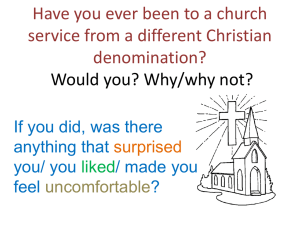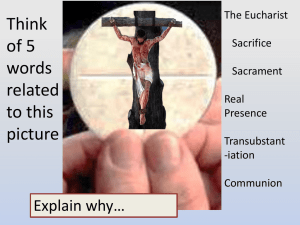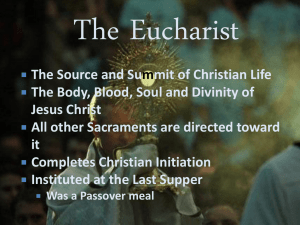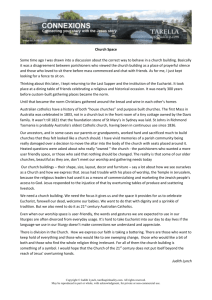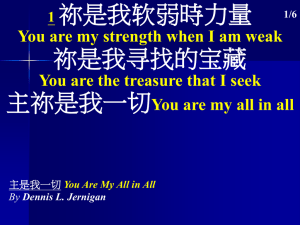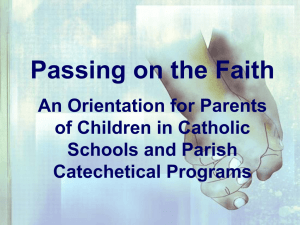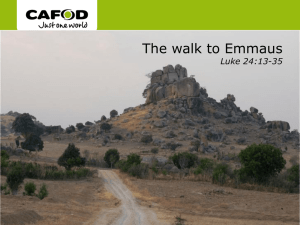The History of the Mass - Most Holy Rosary Catholic Church
advertisement
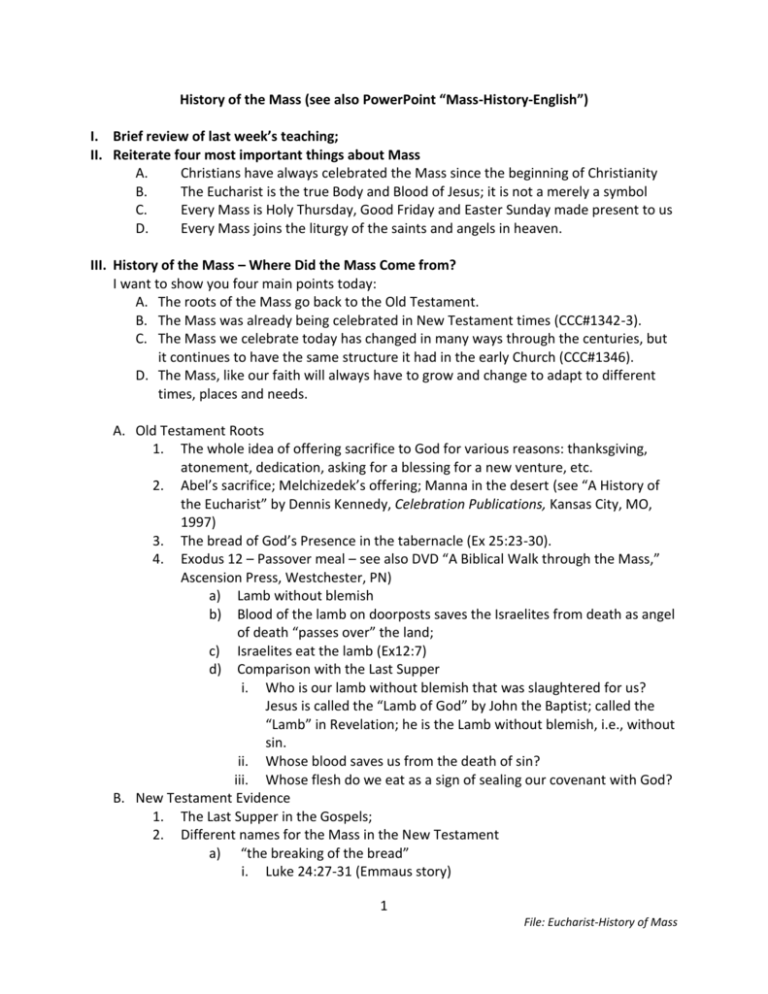
History of the Mass (see also PowerPoint “Mass-History-English”) I. Brief review of last week’s teaching; II. Reiterate four most important things about Mass A. Christians have always celebrated the Mass since the beginning of Christianity B. The Eucharist is the true Body and Blood of Jesus; it is not a merely a symbol C. Every Mass is Holy Thursday, Good Friday and Easter Sunday made present to us D. Every Mass joins the liturgy of the saints and angels in heaven. III. History of the Mass – Where Did the Mass Come from? I want to show you four main points today: A. The roots of the Mass go back to the Old Testament. B. The Mass was already being celebrated in New Testament times (CCC#1342-3). C. The Mass we celebrate today has changed in many ways through the centuries, but it continues to have the same structure it had in the early Church (CCC#1346). D. The Mass, like our faith will always have to grow and change to adapt to different times, places and needs. A. Old Testament Roots 1. The whole idea of offering sacrifice to God for various reasons: thanksgiving, atonement, dedication, asking for a blessing for a new venture, etc. 2. Abel’s sacrifice; Melchizedek’s offering; Manna in the desert (see “A History of the Eucharist” by Dennis Kennedy, Celebration Publications, Kansas City, MO, 1997) 3. The bread of God’s Presence in the tabernacle (Ex 25:23-30). 4. Exodus 12 – Passover meal – see also DVD “A Biblical Walk through the Mass,” Ascension Press, Westchester, PN) a) Lamb without blemish b) Blood of the lamb on doorposts saves the Israelites from death as angel of death “passes over” the land; c) Israelites eat the lamb (Ex12:7) d) Comparison with the Last Supper i. Who is our lamb without blemish that was slaughtered for us? Jesus is called the “Lamb of God” by John the Baptist; called the “Lamb” in Revelation; he is the Lamb without blemish, i.e., without sin. ii. Whose blood saves us from the death of sin? iii. Whose flesh do we eat as a sign of sealing our covenant with God? B. New Testament Evidence 1. The Last Supper in the Gospels; 2. Different names for the Mass in the New Testament a) “the breaking of the bread” i. Luke 24:27-31 (Emmaus story) 1 File: Eucharist-History of Mass ii. iii. iv. v. b) c) “When he [Jesus] was at table with them, he took the bread and blessed and broke it, and gave it to them. And their eyes were opened and they recognized him…” Luke 24:35 “Then they told their story of what had happened on the road and how they had recognized him at the breaking of bread.” Acts 2:42 “And they held steadfastly to the apostles’ teaching and fellowship, to the breaking of the bread and to the prayers.” Acts 2:46-47 “Each day with one heart they regularly went to the Temple but met in their houses for the breaking of bread;” Acts 20:7 “On the first day of the week [Sunday] we met for the breaking of bread.” “the Lord’s supper” “the table of the Lord” 3. The “Take-Bless-Break-Give” motif in feeding of the multitudes in all four Gospels as a reference to the Eucharist 4. Summary: the Mass has been celebrated since the beginning of Christianity. C. Early Church “But every Lord's day gather yourselves together, and break bread, and give thanksgiving after having confessed your transgressions, that your sacrifice may be pure” (Didache, chapter 14). “On the day which is called after the sun, all who are in the towns and in the country gather together for a communal celebration. And then the memoirs of the Apostles or the writings of the prophets are read, as long as time permits. After the reader has finished his task, the one presiding gives an address, urgently admonishing his hearers to practice these beautiful teachings in their lives. Then together all stand and recite prayers...the bread and wine mixed with water are brought, and the bishop offers up prayers and thanksgivings, as much as in him lies. The people assent saying, “Amen.” Then follows the distribution to each and the partaking of the things which have been made Eucharist....” (St. Justin Martyr, First Apology 67) Do you recognize his description of the Mass in 150 AD? What are the elements it had that we still have today? Readings from Scripture 2 File: Eucharist-History of Mass Explanation of Scripture Prayers (including Eucharistic prayers) Holy Communion So, as you can see, the Mass really has not changed that much in all these centuries! Mass was celebrated in Aramaic at first because most Christians were also Jews. It was also celebrated mostly in people’s homes. D. Development of the Mass through the Centuries 1. The Mass from 30 AD – 313 AD a) Persecuted church: 10 waves of persecutions throughout those 300 years. b) “Underground” Church – even when there wasn’t persecution, they were not able to have a lot of publicity or visibility. Mass was celebrated in private homes or in the catacombs. c) Mass came to be celebrated in Greek during these first three centuries which was the spoken language of most of the Roman Empire. d) Constantine’s Edict of Milan gave Christians a reprieve from persecutions. 2. The Mass from 313 – 600 AD a) The Church is freed from persecution and becomes state-supported! Therefore, it becomes much more public. b) By the end of that century, Catholicism (Christianity) becomes the official state religion! Now the Church grew in size and power. Government buildings – called basilicas – as well as pagan temples were turned into Catholic churches. c) The Mass became more formalized and structured because of the larger crowds and the larger buildings. d) The Mass comes to be celebrated in Latin, the spoken language of the people. Also, Christian religious leaders begin to take on some of the dress, customs and authority of Roman gentlemen or senators. e) Pope St. Gregory I (590-604) organized the Mass into a basic form for all Christians; the Liturgy of the Word was organized almost exactly as it is today. Songs and processions became a part of the Mass. 3. The Mass from 600 – 1570 a) During the Middle Ages, the Mass changed dramatically for cultural, political and theological reasons. The heresy of Arianism – the belief that Jesus was not really divine – caused the Church to emphasize Jesus’ divinity almost to the exclusion of his humanity. Jesus came to be perceived as a transcendent and remote God far above us human beings. This led to a greater separation of the laypeople from the clergy and from the laity’s active participation in the liturgy; lay ministries, 3 File: Eucharist-History of Mass such as that of lector (reader of the Scriptures), were taken over by priests. Communion was no longer received in the hand but only on the tongue; in fact, reception of communion became altogether rare because people felt unworthy to receive the divine Christ. 4. b) By the late Middle Ages, the Mass was often no longer a public event but a private act of the priest who mostly prayed silently with his back to the people on a high altar far removed from the congregation who were sometimes even separated by a grill and/or altar rail. And, because Latin was no longer the common language of the people but only of the priests and the elite, the Latin Mass became unintelligible to most, and the people became passive observers. So, during Mass people mostly focused on their private devotions rather than participating in the celebration except for scattered moments, e.g., at the consecration when the bells were rung to call their attention. c) Thus, unlike earlier centuries, Mass was no longer perceived as entering into the dying and rising of Christ made present in the Eucharist in order to transform the gathered community; instead, it was just a remembrance of those past events. More emphasis came to be placed upon the consecrated elements of Christ’s Body and Blood; adoration of the Blessed Sacrament and processions with the consecrated host became popular devotions. In many places, seeing and adoring Christ in the Eucharist became more important than receiving communion. Instead of having only one altar, churches would have several altars where priests could celebrate private Masses for themselves or for special individuals or groups. The Mass and the Eucharist came to be surrounded by fear, awe and even superstition. The Eucharist became more an object than an action, an awesome mystery more than a joyful and unifying community celebration. The Mass from 1570 – 1965 The Catholic Church struggled with many issues and problems in the Middle Ages. Eventually, in the early 16th century, some Catholics became so frustrated and disillusioned that they left the Catholic Church and began their own churches; this came to be known as the Protestant Reformation. In order to deal with this crisis and to try to reform the Church, the Council of Trent was convened from 1545-1563. In order to correct some of the abuses that had crept into the celebration of the Mass and to provide a sense of cohesion for the Church in this time of division and unrest, the Council of Trent authorized a uniform Latin Mass that would be celebrated in every Catholic Church in the world. This “Tridentine” Latin Mass remained basically the same until after Vatican II in the 1960’s. It is the Mass that most Catholics over 60 grew up with. 4 File: Eucharist-History of Mass 5. The Mass from 1965 – Today Vatican Council II 1962-65 What changes did the Council make in the Mass? “Mother Church earnestly desires that all the faithful should be led to that fully conscious, and active participation in liturgical celebrations which is demanded by the very nature of the liturgy” (Constitution on the Sacred Liturgy, chapter 1 #14). Vernacular language Priest faces the people Participation of laypeople Communion under both species Communion in the hand Contemporary music Communal Celebration The Mass of today stresses a more active role for the people and a stronger emphasis on Scripture. A. The Mass Today 1. The Mass of today stresses a more active role for the laity and a stronger emphasis on Scripture than the Mass before Vatican II. It has a basic structure and format wherever it is celebrated throughout the world, yet each culture has its own flavor or style in celebrating the Eucharist: Masses in Kenya with liturgical dance, charismatic/healing Masses, formal “high” Masses in Latin, quiet/prayerful/subdued Masses vs. exuberant/boisterous Masses, etc. 2. We may prefer one style to another, but all Masses have the same power of making Jesus’ passion, death and resurrection present to us. B. Summary 1. The Mass has many roots in the Old Testament, especially in the Passover meal of the Jewish people. 2. It has been celebrated from the very beginning of Christianity although it was given different names in the New Testament. 3. It has developed in many ways down through the ages, but it is still the Last Supper of Holy Thursday, the sacrifice of Jesus on Good Friday and his resurrection on Easter Sunday, and it still has the same basic structure it had in the early Church: readings from Scripture, homily, prayers, Holy Communion. 4. The Mass, like our faith will always have to grow and change to adapt to different times, places and needs. 5 File: Eucharist-History of Mass

